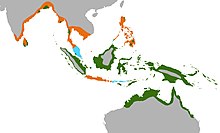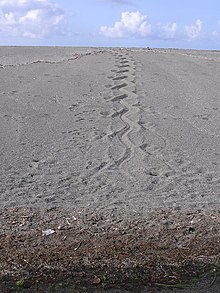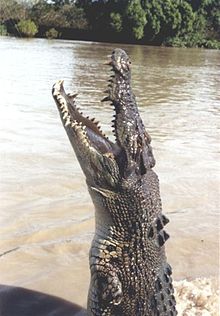Saltwater crocodile
| Saltwater crocodile | ||||||||||||
|---|---|---|---|---|---|---|---|---|---|---|---|---|

Saltwater crocodile ( Crocodylus porosus ) |
||||||||||||
| Systematics | ||||||||||||
|
||||||||||||
| Scientific name | ||||||||||||
| Crocodylus porosus | ||||||||||||
| ( Schneider , 1801) |
The estuarine crocodile ( Crocodylus porosus ), also known as the saltwater crocodile or saltie , is the largest crocodile living today , followed by the Nile crocodile . It is a type of real crocodile (Crocodylidae). The estuarine crocodile is the furthest-penetrating species of crocodile into the ocean, but is also often found in brackish water , rivers and swamps inland. Saltwater crocodiles, like the pointed crocodiles, can live in both salt and fresh water.
features
Male estuarine crocodiles usually reach a length of 4.6–5.2 m, the females remain significantly smaller at 3.1–3.4 m. Such dimensions are already rare, especially in populations affected by human influence: In Bentota Ganga ( Sri Lanka ), Gramentz (2008) observed only one specimen of more than 2.5 m in length out of 16 specimens. Another study looked at saltwater crocodiles from Palau - none of them were taller than 3.3 m. Often the maximum lengths are given for saltwater crocodiles that are significantly greater than these dimensions; in practice, however, body parts of such crocodiles are almost never handed down as evidence. It is said that a hunter shot a crocodile that was 8.5 meters in length in the 1950s. Webb & Manolis (1989) consider this record to be the most reliable record length. A male specimen with at least 6.17 m has recently been guaranteed. 4 m long estuarine crocodiles weigh an average of 240 kg, extremely large specimens can weigh around 1 t.
The body is very broad with a large and broadly trained snout, which makes it easy to distinguish it from the gharial and the Australian crocodile . Two raised ridges (ridges) run from the eyes to the middle of the snout, which gave the saltwater crocodile its German name. The adult animals are gray to gray-brown or golden-brown, but completely black ( melanism ) and white ( albinism ) specimens are also known. The young animals are lighter in color and have dark markings made up of spots and transverse ligaments, which many animals lose as they age. The armor on the back is very even and the shape of the individual scales is oval. There is no armor directly behind the head. They have sensory cells on their stomach and snout that can be used to perceive vibrations in the water.
Detail views:
distribution
The distribution area is very large. It stretches from the East Indies through Southeast Asia to Northern Australia and includes the entire oceanic island world. The exact extent of this distribution has not yet been finally clarified, these crocodiles have even been sighted on the Palau Islands , the Cocos Islands , the New Hebrides and Fiji . Saltwater crocodiles were also found in the western Indian Ocean on the Seychelles and on Aldabra until the beginning of the 19th century . This makes it the crocodile with the largest range of all. One of the reasons for this is certainly the “range” of the species: specimens were seen 1000 km from land on the high seas. A male of the species traveled 1,400 km from Palau to Pohnpei in Micronesia . Barnacles , which are otherwise only found in pelagic marine animals, have even been found on some representatives of this species .
The estuarine crocodile's actual habitat are estuaries and mangrove swamps. These are mostly brackish water zones; however, it also penetrates deeply into freshwater rivers and can also be found in large inland lakes and swamps.
Way of life
nutrition
Young estuarine crocodiles feed mainly on insects and small amphibians. With increasing body size, mainly fish and turtles, but also mammals and birds of all kinds are eaten. Other smaller crocodiles such as the Siamese crocodile may also be captured. Cannibalism is more common: A saltwater crocodile population near Darwin was observed to recover when the hunt was stopped. In the second year the population declined again as the first year kittens began to eat the new generation.
Hunting methods
Saltwater crocodiles use several methods to hunt their prey:
- They jump out of the water, grab their prey and drown it.
- If it is a more able-bodied animal, they grab it and spin on its own axis to tear the prey from its legs.
- If it is also large prey, they can break the animal's bones with blows to the skull and then pull it easily into the water.
- When they hunt fish, they swim alongside towards the bank, cornering the fish and leaving a gap between their mouth and bank. When the fish swim by there, they snap.
- When buffalo or the like cross a river, several crocodiles grab at the same time and drown the victim.
metabolism
There have been reports that estuarine crocodiles can live without food for up to a year and seem to rely on the fat stores in their tails. They owe this ability - as well as their endurance when crossing the oceans - to their extremely controllable metabolism. If mammals need up to 80% of their food to maintain their body temperature, crocodiles get by with ten percent. Saltwater crocodiles can lower their pulse to two heartbeats in three minutes. That way, they can dive for up to an hour or go without food for twelve months.
Reproduction
The females of the estuarine crocodile become sexually mature at ten years of age, while males reach sexual maturity at around 16 years of age. At the beginning of the mating season, the males roar to attract females, but do not do so as often as the Mississippi alligator because they live in open countryside. The territorial behavior of the males increases during this time. After mating, the male continues to strongly defend the territory. During the breeding season in the wet season, a mound nest is built from plant materials, which can be 30 to 80 centimeters high and 120 to 250 centimeters in diameter. Such a nest contains 60 to 80 eggs and is guarded until the young hatch. The rotting plants generate putrefactive heat that accelerates the hatching of the eggs. Brood care for up to three months has often been observed. When the young have hatched, the crocodiles watch over their brood for eight weeks, whose almost 70% chance of survival is also an exception. The maximum life expectancy of saltwater crocodiles is over 70 years.
Natural enemies
Young animals have many enemies, for example storks, birds of prey, large fish and larger conspecifics. When saltwater crocodiles are fully grown, they hardly have any natural predators. Sometimes small to medium-sized crocodiles are preyed on by large pythons or tigers.
Man and crocodile
In northern Australia there is a documented crocodile attack about twice a year. Between 1971 and 2004, 62 unprovoked attacks were registered, 17 of which were fatal. For example, in 2002 a German tourist was killed while bathing in the Kakadu National Park . In order to avoid such attacks, saltwater crocodiles are caught by game rangers at bathing areas and removed. Attempts are also being made to protect beaches with nets. Particularly aggressive crocodiles that have attacked several times are called " rogue crocodiles " ("rogue crocodiles"). Probably the best known “ rogue crocodile ” was Sweetheart , which severely damaged 15 fishing boats between 1971 and 1979, but largely ignored the occupants and injured no one.
During the Pacific War of 1941–45, a fatal disaster allegedly occurred: In February 1945, English / Indian combat troops landed on the Ramree Islands off the south coast of Burma, which were still occupied by the Japanese. The Japanese commander refused an offer of surrender and decided with his force of around 1000 men to break out of the encirclement at night across the extensive mangrove swamps to the open sea. This decision turned out to be fatal and ended in catastrophe. Hundreds of saltwater crocodiles lurked in the mangrove swamps and allegedly caused a massacre among the fleeing Japanese. Only 20 Japanese who surrendered to the British the next morning had survived the night. In the Guinness Book of Records, the event is listed as the greatest disaster that animals (here: estuarine crocodiles) have ever caused among humans. However, the correctness of this representation is disputed and referred to by other authors as a modern myth ("urban legends"), as there is no real evidence for the historicity of the incident. In particular, there are no indications in the British military reports and none of the Japanese and local eyewitnesses interviewed could confirm the incident.
The estuarine crocodile population decreased in the 1950s and 1960s because their skin is suitable for leather production and they were therefore heavily hunted. The population recovered 20 years ago because they found their habitat largely untouched. Ever since saltwater crocodiles were protected by the Washington Convention of 1973, they have been bred on farms for leather production; the meat is sold as food in Australia.
Among other things, they serve as tourist attractions on the Adelaide River near Darwin in the Australian Northern Territory : pieces of meat are held over the water on a fishing rod from a large boat: the saltwater crocodiles ( Jumping Crocodiles ) then jump out of the water up to a height of a few meters and snap the chunks of meat (see photo). Saltwater crocodiles became known worldwide through the films in the Crocodile Dundee series.

In East Timor the saltwater crocodile is revered as the “grandfather crocodile”. The origin of this is the legend of the good crocodile , according to which the island of Timor emerged from a crocodile. Since the hunt for crocodiles ceased after the Indonesian occupation left, crocodile attacks have increased rapidly. CrocBITE, the database for crocodile attacks from Charles Darwin University , has registered 15 fatal and five other attacks in East Timor, a country the size of Schleswig-Holstein and a little more than a million inhabitants, since 2007 (as of Sep. 2016).
Since 1995, the database registered a total of 1024 attacks by saltwater crocodiles on humans, 591 of which were fatal. About half of all crocodile attacks worldwide are caused by saltwater crocodiles. The second most common Nile crocodile causes only a quarter of all global incidents, but two-thirds were fatal to the victim.
The animal is used as a motif for a silver bullion coin , the saltwater crocodile , issued in 2014 by the Australian mint , the Perth Mint , and for similar collector coins from the same publisher.
Saltwater crocodile Max (1956–2015) at Dresden Zoo
literature
- Joachim Brock: Crocodiles. A life with the armored lizards , (terrarium library), Natur - & - Tier-Verlag, Münster, 1998, ISBN 3-931587-11-8
- Charles A. Ross (Ed.): Crocodiles and Alligators. Development, biology and dissemination , Orbis Verlag, Niedernhausen / Ts. 2002, ISBN 3-572-01319-4
- G. Webb & C. Manolis (1989): Australian Crocodiles - A Natural History . Reed New Holland, Sydney, Auckland, London & Cape Town 2007 (reprint of the original edition from 1989). ISBN 978-1-876334-26-0
Web links
- Crocodylus porosus in the endangered Red List species the IUCN 2006. Posted by: Crocodile Specialist Group, 1996. Retrieved on 9 May, 2006.
- Crocodylus porosus in The Reptile Database
- CrocBITE - Worldwide Crocodilian Attack Database
Individual evidence
- ^ A b c Webb & Manolis (1989): 65
- ↑ D. Gramentz (2008): On the abundance, spatial distribution and threat of Crocodylus porusus in Bentota Ganga, Sri Lanka . Elaphe 16 (3): 41-52
- ↑ a b Peter Brazaitis, Joshua Eberdong, Peter John Brazaitis and Gregory J. Watkins-Colwell (2009) Notes on the Saltwater Crocodile, Crocodylus porosus, in the Republic of Palau In: Bulletin of the Peabody Museum of Natural History 50 (1) Pp. 27-48, doi : 10.3374 / 014.050.0103 .
- ↑ "Australia: Rangers catch 600 kilo giant crocodile" on Spiegel Online on July 10, 2018
- ^ G. Webb & C. Manolis (2009): Crocodiles of Australia : 9. New Holland Publishers (Australia). ISBN 978-1-74110-848-4
- ^ Current Distribution - Saltwater or Estuarine Crocodile (Crocodylus porosus). Retrieved April 8, 2020 .
- ↑ Gerlach, J. & Canning, L. 1994. On the crocodiles of the western Indian Ocean . Phelsuma 2: 56-60
- ^ Charles A. Ross: Crocodiles and Alligators. Development, biology and dissemination. Pp. 175-177
- ^ Animal Encyclopedia
- ↑ Crocodile Attack in Australia: An Analysis of Its Incidence and Review of the Pathology and Management of Crocodilian Attacks in General , David GE Caldicott et al. In: Wilderness and Environmental Medicine , Vol. 16, No. 3, pages 143-159.
- ↑ Fatal accident while swimming in a national park at night: German tourist in Australia attacked by a crocodile . In: Neue Zürcher Zeitung . October 23, 2002, ISSN 0376-6829 ( nzz.ch [accessed January 4, 2017]).
- ↑ Platt, SG, WK Ko, M. Kalyar Myo, LL Khaing, and T. Rainwater (2001): Man eating by estuarine crocodiles: the Ramree Island massacre revisited. Herpetological Bulletin 75: 15-18.
- ^ Frank McLynn: The Burma Campaign: Disaster Into Triumph, 1942-45 . Yale University Press 2011, ISBN 978-0-300-17162-4 , pp. 13–15, 459 ( excerpt from Google book search)
- ^ Animal Encyclopedia
- ↑ Reinhard Radke crocodiles. Expedition to the heirs of the dinosaurs
- ↑ a b CrocBITE - Worldwide Crocodilian Attack Database , accessed September 4, 2016.












